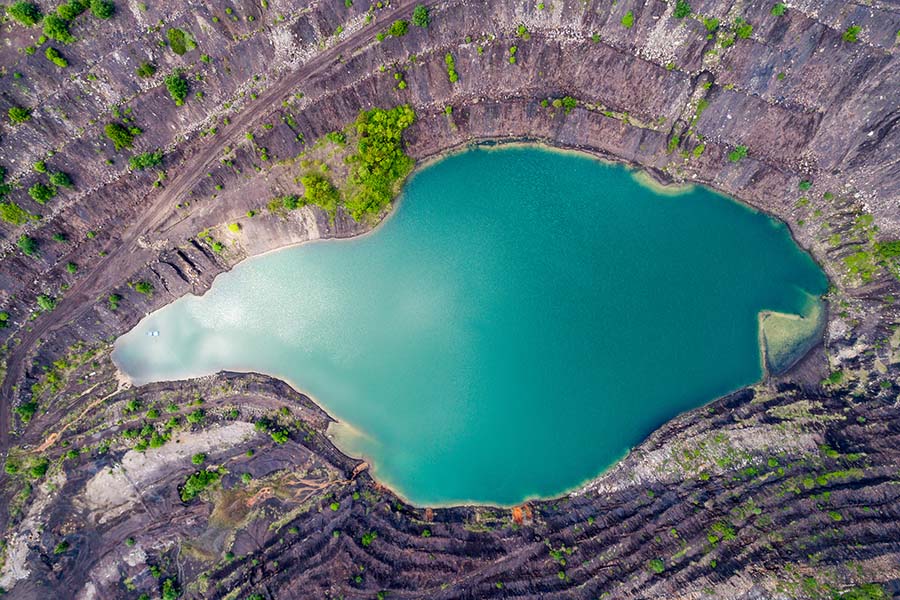Evaporation ponds are widely used throughout the various branches of the mining industry. The earliest forms of these ponds were used for harvesting salt thousands of years ago, and today’s salt industry still relies on large scale shallow ponds for this process. Now evaporation ponds are also used for mineral extraction, ore separation, and other important industrial processes. Lithium and uranium production alone accounts for a large percentage of today’s mining evaporation ponds. With so many highly concentrated mixtures being processed in these ponds, it’s clear that proper lining is essential for both profitable and safe production.
How Do Evaporation Ponds Work?
Regardless of what they contain or the desired rate of evaporation, all ponds built for this purpose share some common features. They tend to be very shallow and have a large surface area rather than depth. This keeps fluids exposed to the surface to speed up evaporation through both wind and solar radiation. Water only evaporates from the surface where it meets the air, so large and shallow ponds work best for these applications. Deeper ponds, lakes, and tanks slow evaporation instead, making them more appropriate for long-term storage. Some evaporation ponds dry down until there is practically no liquid left, while others produce a concentrated sludge that requires further treatment or processing.
Why is Lining Essential?
Evaporation rates may be accelerated in these ponds, but they’re still highly controlled. Unlined ponds also lose water downward through seepage through the soil. This, speeds up the concentration process more than what’s intended, resulting in incomplete treatment or loss of valuable chemicals and minerals. Liners prevent seepage from affecting the speed of treatment, in addition to protecting the surrounding soil and water from environmental damage. With the right mining geomembrane liner, evaporation ponds can be used to process the harshest and most hazardous mixtures without concerns about the effects on the surrounding area.
Are Covers Needed?
Off-gassing is a major problem with certain types of mining evaporation ponds. Most ores don’t create many gases on their own, but the addition of solvents and other chemicals to induce metal separation can lead to the development of methane and hydrogen sulfide. If the ponds are located in areas near workers or residential areas, covers and active gas management systems are usually required for safety. Since these gases can be flammable, the covers used to contain them must be reliable and strong enough to withstand the rising and falling pressure levels without rupturing. Reinforced materials are much safer to use as gas covers during certain stages of evaporation or pre-processing.
Why is Depth Essential in the Evaporation Pond?
Controlling the depth of the pond is the primary method for regulating the evaporation rate. Deeper ponds evaporate more slowly because of the reduced contact with the air. The deeper water also tends to stay cooler and resist the warming effects of the sun, further slowing evaporation rates. If a particular mining process requires a slow rate of water loss to allow time for settling or exposure to chemicals, plan for a deeper design that requires steep banks and therefore a more durable geomembrane liner.
How Does Surface Area Affect Evaporation Rates?
The second most important factor that goes into the evaporation rate of a particular mining pond is its total surface area. Increasing the surface area also increases the amount of contact the water makes with the air, which is the only point at which evaporation actually occurs. A very shallow pond will still have a slow rate of evaporation if it also has a small surface area. However, multiplying the surface area still has a smaller effect on the evaporation rate than depth alone for most mining mixtures. Make sure to adjust both measurements when aiming for a particular evaporation rate to achieve maximum ore or mineral extraction.
When Do Geomembranes Need Underlayment?
Liners used in evaporation ponds may need an additional underlayment to protect the geomembrane from rips and tears. Leaks in evaporation ponds for mines tend to be more serious than those for other wastewater products because these ponds are used to process highly concentrated materials. There’s no dilution to mitigate the environmental effects of a leak. Underlayment protects the impermeable liner above them by acting as a cushion that softens the sharp edges of rocks and covers small voids. This reduces stress across the entire surface of the liner, preventing punctures and tears from developing over time. Rough and uneven soil will likely benefit from an underlayment cover before the geomembrane slides into place.
Evaporation ponds definitely need liners that can handle direct and constant chemical exposure. RPE is a particularly good choice for this application. Check out our products here at BTL Liners to find a commercial geomembrane that is a good fit for your mining project.




